典范英语3教学ppt
- 格式:ppt
- 大小:8.29 MB
- 文档页数:21
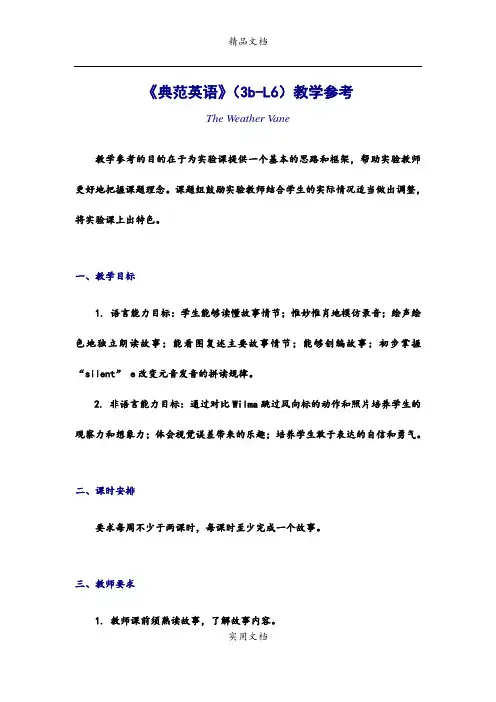
《典范英语》(3b-L6)教学参考The Weather V ane教学参考的目的在于为实验课提供一个基本的思路和框架,帮助实验教师更好地把握课题理念。
课题组鼓励实验教师结合学生的实际情况适当做出调整,将实验课上出特色。
一、教学目标1. 语言能力目标:学生能够读懂故事情节;惟妙惟肖地模仿录音;绘声绘色地独立朗读故事;能看图复述主要故事情节;能够创编故事;初步掌握“silent” e改变元音发音的拼读规律。
2. 非语言能力目标:通过对比Wilma跳过风向标的动作和照片培养学生的观察力和想象力;体会视觉误差带来的乐趣;培养学生敢于表达的自信和勇气。
二、课时安排要求每周不少于两课时,每课时至少完成一个故事。
三、教师要求1. 教师课前须熟读故事,了解故事内容。
2. 对于较难的单词,教师可板书,并配合动作和表情帮助学生理解。
3. 全英文授课。
四、教学用具多媒体设备、CD机、课件(课题组提供)、故事图片(1、3、6、7、8、9)、词组卡(the building site/the crane/the cab/a van/the weather vane/jump over/took a photograph/went on the roof/ tall story/see)、视觉误差图片。
五、课堂教学基本步骤1. 导入(Lead-in):观看视频,认识风向标(1)教师播放视频Weather Vane DIY(见课件):Now I’m going to show you a DIY video. It tells how to make a weather vane.(2)教师展示两幅风向标图片,与学生互动,并自然过渡到讲故事环节:Where do we usually see a weather vane?What is the weather vane used for?Today we are going to read a story The Weather Vane. What would happen?Let’s have a look.2. 看图讲故事(Storytelling):理解故事情节,观察Wilf是否真能跳过房顶上的风向标教师利用课件逐幅播放故事图片,并用丰富的表情、生动的英文和适当的肢体语言给学生绘声绘色地讲故事,让学生观察Wilf是如何跳过风向标的。
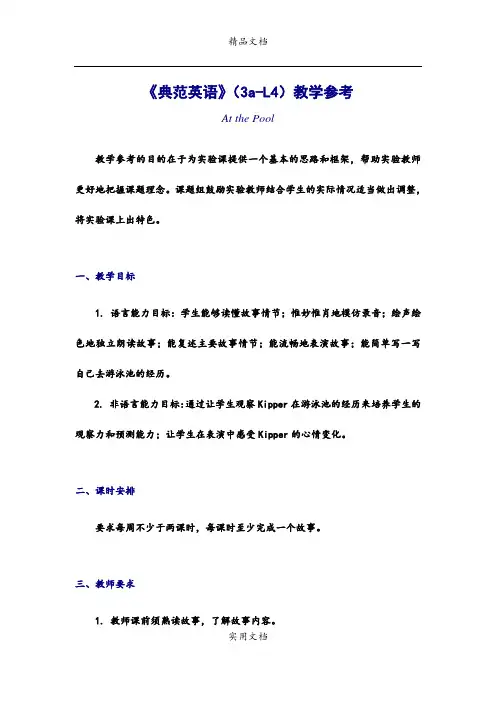
《典范英语》(3a-L4)教学参考At the Pool教学参考的目的在于为实验课提供一个基本的思路和框架,帮助实验教师更好地把握课题理念。
课题组鼓励实验教师结合学生的实际情况适当做出调整,将实验课上出特色。
一、教学目标1. 语言能力目标:学生能够读懂故事情节;惟妙惟肖地模仿录音;绘声绘色地独立朗读故事;能复述主要故事情节;能流畅地表演故事;能简单写一写自己去游泳池的经历。
2. 非语言能力目标:通过让学生观察Kipper在游泳池的经历来培养学生的观察力和预测能力;让学生在表演中感受Kipper的心情变化。
二、课时安排要求每周不少于两课时,每课时至少完成一个故事。
三、教师要求1. 教师课前须熟读故事,了解故事内容。
2. 对于较难的单词,教师可板书,并配合动作和表情帮助学生理解。
3. 全英文授课。
四、教学用具多媒体设备、课件(课题组提供)、道具(泳衣、泳裤、泳帽、泳镜)。
五、课堂教学基本步骤1. 导入(Lead-in):介绍游泳相关装备,引入故事情景教师通过展示实物(或用图片代替)和提问,介绍游泳时会用到的一些装备,为看图讲故事做好铺垫。
Do you like swimming?Do you often go to the swimming pool? (展示游泳池图片)What do we need when we go to the pool? (请学生自由回答)We need a swimming cap. Here’s a swimming cap. (展示泳帽,请学生摸一摸)We need goggles. Do you want to try them on? (展示泳镜,请学生戴一戴)Look! What are they? (展示泳衣、泳裤图片)They are swimsuits and swimming trunks.Do you have swimsuits/swimming trunks?One day, the children went to the swimming pool.Look! What happened to Kipper? (展示故事第4幅图)Let’s learn a new story At the Pool.2. 看图讲故事(Storytelling):理解故事情节,观察Kipper在游泳池的经历,体会Kipper的心情变化教师利用课件逐幅播放故事图片,并用丰富的表情、生动的英文和适当的肢体语言给学生绘声绘色地讲故事,让学生观察Kipper在游泳池的经历。
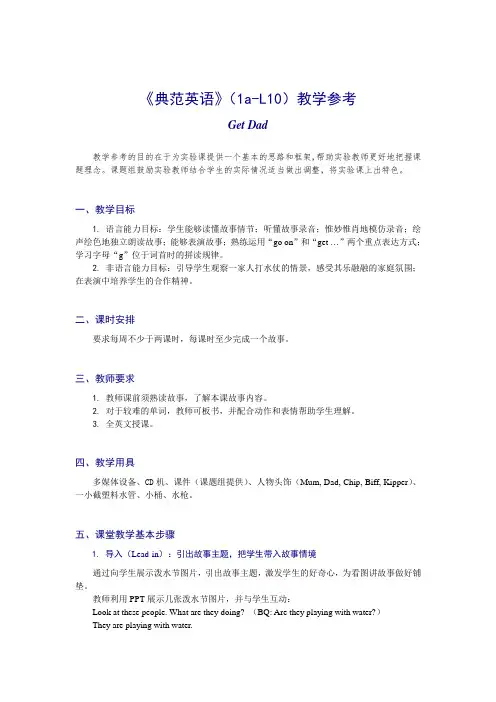
《典范英语》(1a-L10)教学参考Get Dad教学参考的目的在于为实验课提供一个基本的思路和框架,帮助实验教师更好地把握课题理念。
课题组鼓励实验教师结合学生的实际情况适当做出调整,将实验课上出特色。
一、教学目标1. 语言能力目标:学生能够读懂故事情节;听懂故事录音;惟妙惟肖地模仿录音;绘声绘色地独立朗读故事;能够表演故事;熟练运用“go on”和“get …”两个重点表达方式;学习字母“g”位于词首时的拼读规律。
2. 非语言能力目标:引导学生观察一家人打水仗的情景,感受其乐融融的家庭氛围;在表演中培养学生的合作精神。
二、课时安排要求每周不少于两课时,每课时至少完成一个故事。
三、教师要求1.教师课前须熟读故事,了解本课故事内容。
2.对于较难的单词,教师可板书,并配合动作和表情帮助学生理解。
3.全英文授课。
四、教学用具多媒体设备、CD机、课件(课题组提供)、人物头饰(Mum, Dad, Chip, Biff, Kipper)、一小截塑料水管、小桶、水枪。
五、课堂教学基本步骤1. 导入(Lead-in):引出故事主题,把学生带入故事情境通过向学生展示泼水节图片,引出故事主题,激发学生的好奇心,为看图讲故事做好铺垫。
教师利用PPT展示几张泼水节图片,并与学生互动:Look at these people. What are they doing? (BQ: Are they playing with water?)They are playing with water.Do you like playing with water?Do you play a water game in summer?之后,自然过渡到讲故事环节:Kipper’s family like playing with water. One day, they played a water game. How did they play? Let’s learn the story.2. 看图讲故事(Storytelling):理解故事情节,观察一家人打水仗的情景教师利用课件逐幅播放故事图片,并用丰富的表情、生动的英文和适当的肢体语言给学生绘声绘色地讲故事,引导学生观察一家人打水仗的情景,充分感受他们的愉悦心情和其乐融融的家庭氛围。
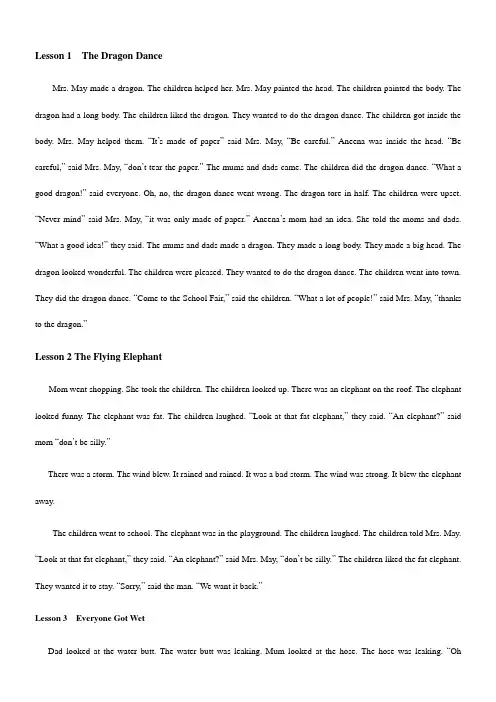
Lesson 1 The Dragon DanceMrs. May made a dragon. The children helped her. Mrs. May painted the head. The children painted the body. The dragon had a long body. The children liked the dragon. They wanted to do the dragon dance. The children got inside the body. Mrs. May helped them. “It’s made of paper”said Mrs. May, “Be careful.”Aneena was inside the head. “Be careful,” said Mrs. May, “don’t tear the paper.” The mums and dads came. The children did the dragon dance. “What a good dragon!” said everyone. Oh, no, the dragon dance went wrong. The dragon tore in half. The children were upset. “Never mind” said Mrs. May, “it was only made of paper.” Aneena’s mom had an idea. She told the moms and dads. “What a good idea!” they said. The mums and dads made a dragon. They made a long body. They made a big head. The dragon looked wonderful. The children were pleased. They wanted to do the dragon dance. The children went into town. They did the dragon dance. “Come to the School Fair,” said the children. “What a lot of people!” said Mrs. May, “thanks to the dragon.”Lesson 2 The Flying ElephantMom went shopping. She took the children. The children looked up. There was an elephant on the roof. The elephant looked funny. The elephant was fat. The children laughed. “Look at that fat elephant,” they said. “An elephant?” said mom “don’t be silly.”There was a storm. The wind blew. It rained and rained. It was a bad storm. The wind was strong. It blew the elephant away.The children went to school. The elephant was in the playground. The children laughed. The children told Mrs. May. “Look at that fat elephant,” they said. “An elephant?” said Mrs. May, “don’t be silly.” The children liked the fat elephant. They wanted it to stay. “Sorry,” said the man. “We want it back.”Lesson 3 Everyone Got WetDad looked at the water butt. The water butt was leaking. Mum looked at the hose. The hose was leaking. “Ohbother!” said Mum. Dad mended the water butt. He put a patch on it. “What a tricky job!” he said. The water butt burst. All the water came out. Dad go wet. Mum mended the hose. She put a patch on it. “What a tricky job!” she said. Mum put the hose on the tap. The top of the tap came off. Mum got very wet. Dad got a new water butt. He put it on the bricks. He got the hose. He filled up the water butt. The water butt fell over. The water poured out. Dad got wet again. Mum got a new hose. She joined it to the old hose. She wanted to water the roses. Kipper wanted to help. He turned the tap on. Mum got wet again. “Oh no!” said Mum. The children got the paddling pool. They put it on the grass. Dad got the new hose. Biff turned on the tap. No water came out of the hose. “Funny!” said Dad. He looked down the hose. Oh no! The children got wet.Lesson 4 Wet PaintDad was painting the back door. The children were outside. Floppy wanted to come in. He jumped up. He put his paws on the paint. Dad painted the door again. Biff kicked a ball. The ball hit the door. Dad painted the door again. Kipper pushed the door. He got paint on his hands. Dad was fed up. He painted the door again. “What a job!” said Dad. Biff and Chip had a pillow fight. The pillow split open. “Oh no!” said Biff. The wind blew. It blew the feathers. “Oh no!”said Chip. “Wet paint!” There was no wet paint. The door had gone. Dad had put up an old door. The back door was inside. “It’s safe here,” said Dad.Lesson 5 The ScarfAnneena liked knitting. She made a scarf. Annena’s mum helped her. The scarf was long and warm. “It’s a good scarf,” said Anneena. Biff and Chip came to play. It was a cold day. Anneena put on her scarf. “What a cold day!” she said. Biff looked at Anneena’s scarf. “What a long scarf!” she said. “I made it,” said Anneena. “I couldn’t stop knitting.”The children went to the park. They went to the pond. The pond was frozen. They pulled Anneena’s scarf. “Stop it!”shouted Anneena. “Stop it!” shouted Anneena’s mum. A boy went on the ice. The ice was dangerous. “Get off,” shouted Anneena’s mum. “The ice is not safe.” Anneena’s mum couldn’t get the boy. She couldn’t go on the ice. Everyone was frightened. “Help!”shouted the boy. Anneena had a good idea. She took off her scarf. “Make a rope,”she said.Anneena’s mum made a rope. She made it out of scarves and coats. She threw it to the boy. Everyone pulled the rope. They pulled the boy out of the pond. The boy was safe. “Hooray!” shouted Anneena. “I’m sorry!” said the boy. “Thank you.”“Ice is dangerous,” said Anneena. Anneena looked at her scarf. “I’m glad I made it long,” she said.Lesson 6 SwapNadim found a bat. It was broken. Nadim mended the bat. His dad helped. The bat looked good. Chip had a robot. The robot was broken. Chip liked Nadim’s bat. He swapped the robot for the bat. Nadim mended the robot. The robot looked good. Biff had a skateboard. It had no wheels. Biff swapped it for the robot. Nadim mended the skateboard. He put on new wheels. “It’s a good skateboard now,”he said. Wilma had a bike. The bike was broken. She swapped it for the skateboard. Nadim mended the bike. He painted it black. The bike looked good. “Not bad,” said Nadim.Lesson 7 An important CaseThe children were outside. They were playing football. Wilf kicked the ball. It landed in a bush. “Sorry,” said Wilf. Wild couldn’t get the ball. “I can get it,” said Kipper. Kipper found a case. “Look at this,” he said. “I found it in the bush.”Dad looked at the case. He couldn’t open it. Wilf looked at the case. “What can be in it?”he asked. “It looks important.”“What is in it?” asked Wilma. “I don’t know,” said Chip, “but it looks very important.”“What is in the case?” asked Kipper. “I don’t know,” said Biff, “but it looks very, very important.”“What is in this case?” asked dad. “We don’t know,” said the police officer, “but it is very important.” A man came in a big car. “Who is he?” asked Kipper. “I don’t know,” said dad, “but he looks important.”The man took the case. “It’s my case,” he said. “Thank you. It was stolen. It is very important.”The man got in the car. “Excuse me,” said Wilma. “What is in the case?”“Ah!” said the man. “My sandwiches.”1.《古诗词三首》一、生字、新词luó tíng tíng tán ān海螺.亭.台楼阁家庭.潭.水谙.熟二、字义解释闲:形容云彩飘来飘去悠闲自在的样子。
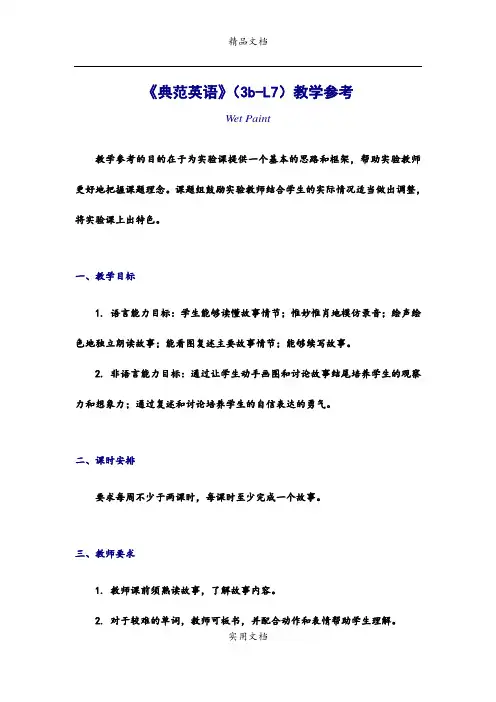
《典范英语》(3b-L7)教学参考Wet Paint教学参考的目的在于为实验课提供一个基本的思路和框架,帮助实验教师更好地把握课题理念。
课题组鼓励实验教师结合学生的实际情况适当做出调整,将实验课上出特色。
一、教学目标1. 语言能力目标:学生能够读懂故事情节;惟妙惟肖地模仿录音;绘声绘色地独立朗读故事;能看图复述主要故事情节;能够续写故事。
2. 非语言能力目标:通过让学生动手画图和讨论故事结尾培养学生的观察力和想象力;通过复述和讨论培养学生的自信表达的勇气。
二、课时安排要求每周不少于两课时,每课时至少完成一个故事。
三、教师要求1. 教师课前须熟读故事,了解故事内容。
2. 对于较难的单词,教师可板书,并配合动作和表情帮助学生理解。
3. 全英文授课。
四、教学用具多媒体设备、CD机、课件(课题组提供)、图片(4扇门,见检查理解环节)。
五、课堂教学基本步骤1. 导入(Lead-in):观看视频,引入故事情境通过视频片段,让学生了解wet paint的概念,引入故事情境。
(1)教师播放视频Wet Paint,通过形象直观的方式帮助学生了解“油漆未干”。
Now let’s watch a cartoon clip called Wet Paint.(2)学生观看视频后,教师提出问题:What was Donald Duck doing?What happened to the paint?Did the car look good at last?(3)学生回答完问题后,自然导入故事。
Dad was also painting something. What was he painting? What happened to the paint? Let’s have a look.2. 看图讲故事(Storytelling):理解故事情节,观察并体会爸爸的心情变化教师利用课件逐幅播放故事图片,并用丰富的表情、生动的英文和适当的肢体语言给学生绘声绘色地讲故事,让学生观察是什么原因让爸爸一遍又一遍地刷漆,同时体会他的心情变化。
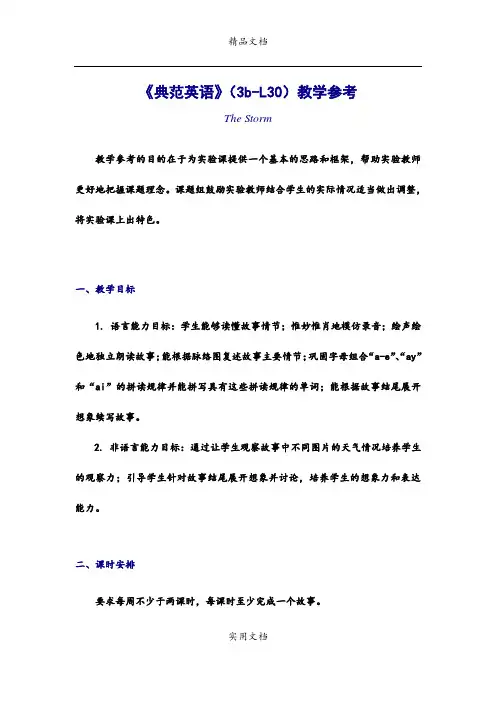
《典范英语》(3b-L30)教学参考The Storm教学参考的目的在于为实验课提供一个基本的思路和框架,帮助实验教师更好地把握课题理念。
课题组鼓励实验教师结合学生的实际情况适当做出调整,将实验课上出特色。
一、教学目标1. 语言能力目标:学生能够读懂故事情节;惟妙惟肖地模仿录音;绘声绘色地独立朗读故事;能根据脉络图复述故事主要情节;巩固字母组合“a-e”、“ay”和“ai”的拼读规律并能拼写具有这些拼读规律的单词;能根据故事结尾展开想象续写故事。
2. 非语言能力目标:通过让学生观察故事中不同图片的天气情况培养学生的观察力;引导学生针对故事结尾展开想象并讨论,培养学生的想象力和表达能力。
二、课时安排要求每周不少于两课时,每课时至少完成一个故事。
三、教师要求1. 教师课前须熟读故事,了解故事内容。
2. 对于较难的单词,教师可板书,并配合动作和表情帮助学生理解。
3. 全英文授课。
四、教学用具多媒体设备、CD机、课件(课题组提供)、钥匙。
五、课堂教学基本步骤1. 导入(Lead-in):温习上一个故事,引入故事情境教师展示上一课的图片(图4),并提问以下问题与学生互动:Do you remember the story The Wizard of Oz?What was the weather like in the story? (展示3b-29图4)There was a storm. The wind blew the house away.When the children went home, there was a storm too. (展示3b-29图13)Do you like storm? Why or why not? (请学生自由回答)学生回答后,自然过渡到讲故事环节:Did the children like the storm? What did they find after the storm? Let’s learn a new story The Storm.2. 看图讲故事(Storytelling):理解故事情节,观察图片中天气的变化教师利用课件逐幅播放故事图片,并用丰富的表情、生动的英文和适当的肢体语言给学生绘声绘色地讲故事,让学生观察图片中天气的变化,了解故事结尾the box的发现过程。
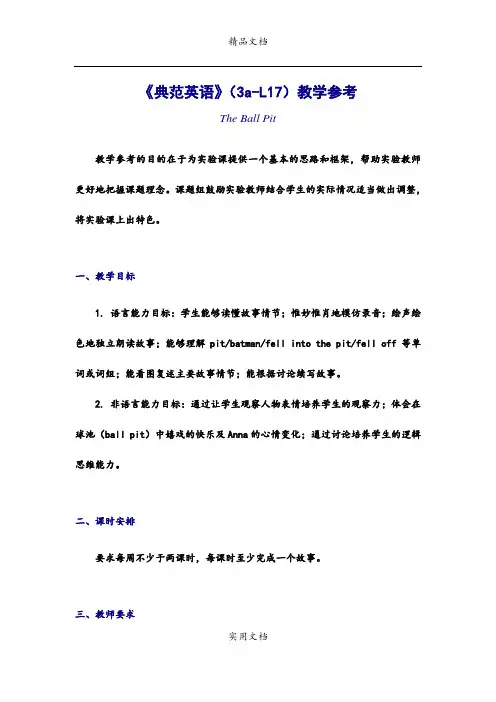
《典范英语》(3a-L17)教学参考The Ball Pit教学参考的目的在于为实验课提供一个基本的思路和框架,帮助实验教师更好地把握课题理念。
课题组鼓励实验教师结合学生的实际情况适当做出调整,将实验课上出特色。
一、教学目标1. 语言能力目标:学生能够读懂故事情节;惟妙惟肖地模仿录音;绘声绘色地独立朗读故事;能够理解pit/batman/fell into the pit/fell off等单词或词组;能看图复述主要故事情节;能根据讨论续写故事。
2. 非语言能力目标:通过让学生观察人物表情培养学生的观察力;体会在球池(ball pit)中嬉戏的快乐及Anna的心情变化;通过讨论培养学生的逻辑思维能力。
二、课时安排要求每周不少于两课时,每课时至少完成一个故事。
三、教师要求1. 教师课前须熟读故事,了解故事内容。
2. 对于较难的单词,教师可板书,并配合动作和表情帮助学生理解。
3. 全英文授课。
四、教学用具多媒体设备、CD机、课件(课题组提供)、故事图片(第9幅图)。
五、课堂教学基本步骤1. 导入(Lead-in):观看视频,了解ball pit通过观看视频和提问,让学生联系实际生活,了解ball pit,为看图讲故事做好铺垫。
教师播放视频短片The Ball Pit(见课件):Now we are going to watch a video clip. It is called The Ball Pit.播放完后,教师就短片内容与学生互动:What can you see in the ball pit?Is it fun to play in the ball pit?Do you like to play in the ball pit?之后,自然过渡到讲故事环节:Last weekend, Mum took Kipper and hisfriend Anna to the ball pit. Did they have fun? What happened in the story? Let’s read the story The Ball Pit.2. 看图讲故事(Storytelling):理解故事情节,观察孩子们在ball pit 嬉戏的情景教师利用课件逐幅播放故事图片,并用丰富的表情、生动的英文和适当的肢体语言给学生绘声绘色地讲故事,让学生观察孩子们在ball pit嬉戏的情景,体会Anna的心情变化。
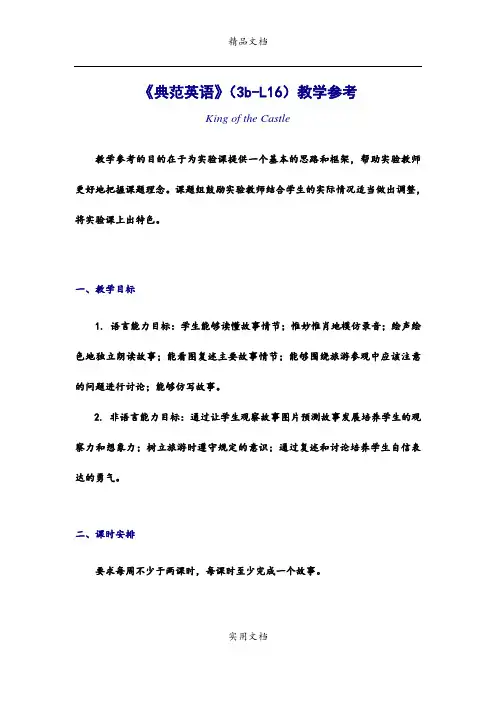
《典范英语》(3b-L16)教学参考King of the Castle教学参考的目的在于为实验课提供一个基本的思路和框架,帮助实验教师更好地把握课题理念。
课题组鼓励实验教师结合学生的实际情况适当做出调整,将实验课上出特色。
一、教学目标1. 语言能力目标:学生能够读懂故事情节;惟妙惟肖地模仿录音;绘声绘色地独立朗读故事;能看图复述主要故事情节;能够围绕旅游参观中应该注意的问题进行讨论;能够仿写故事。
2. 非语言能力目标:通过让学生观察故事图片预测故事发展培养学生的观察力和想象力;树立旅游时遵守规定的意识;通过复述和讨论培养学生自信表达的勇气。
二、课时安排要求每周不少于两课时,每课时至少完成一个故事。
三、教师要求1. 教师课前须熟读故事,了解故事内容。
2. 对于较难的单词,教师可板书,并配合动作和表情帮助学生理解。
3. 全英文授课。
四、教学用具多媒体设备、CD机、课件(课题组提供)、人物图(Nadim, Chip, Biff, Kipper)、单词卡(the king, the queen, the knight)、城堡图片。
五、课堂教学基本步骤1. 导入(Lead-in):通过图片和视频,让学生了解城堡的内外构造,引入故事情境(1)观看视频,了解城堡在战争中的作用。
First, let’s enjoy a video.(播放视频。
视频结束后提问。
)What is the video about?Have you ever been to a castle?What is a castle like?Who do you think live in a castle?(2)展示PPT图片,帮助学生了解城堡构造。
Look! This is a castle.There are usually a moat and many turrets around the castle.The King and his family live in the castle.There are many knights in the castle to protect the royal family.(3)展示标题页,自然引入故事:The family went to see a castle. Did they like it? What happened? L et’s learn the story.2. 看图讲故事(Storytelling):理解故事情节,观察一家人在古堡中的见闻和活动教师利用课件逐幅播放故事图片,并用丰富的表情、生动的英文和适当的肢体语言给学生绘声绘色地讲故事,让学生观察一家人各自在城堡中做了什么。
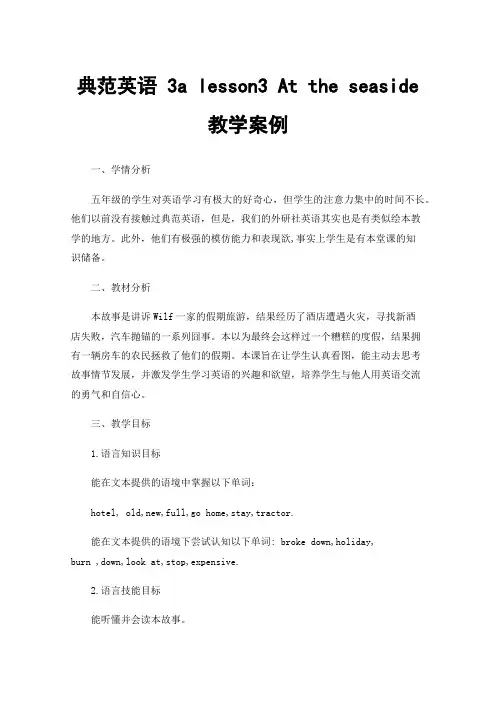
典范英语 3a lesson3 At the seaside教学案例一、学情分析五年级的学生对英语学习有极大的好奇心,但学生的注意力集中的时间不长。
他们以前没有接触过典范英语,但是,我们的外研社英语其实也是有类似绘本教学的地方。
此外,他们有极强的模仿能力和表现欲,事实上学生是有本堂课的知识储备。
二、教材分析本故事是讲诉Wilf一家的假期旅游,结果经历了酒店遭遇火灾,寻找新酒店失败,汽车抛锚的一系列囧事。
本以为最终会这样过一个糟糕的度假,结果拥有一辆房车的农民拯救了他们的假期。
本课旨在让学生认真看图,能主动去思考故事情节发展,并激发学生学习英语的兴趣和欲望,培养学生与他人用英语交流的勇气和自信心。
三、教学目标1.语言知识目标能在文本提供的语境中掌握以下单词:hotel, old,new,full,go home,stay,tractor.能在文本提供的语境下尝试认知以下单词: broke down,holiday,burn ,down,look at,stop,expensive.2.语言技能目标能听懂并会读本故事。
通过绘本图片的细节信息,理解本故事情节,并能够尝试运用重点语句。
能复述并表演这个故事。
3.情感态度目标了解西方国家地道的英语表达和传统的西方文化。
培养学生敢于开口说英语的兴趣及自信心,并培养学生乐于与人相处交流的积极性。
通过学习,使学生能大胆提问,乐于交流。
四、教学重点、难点重点:理解和掌握这些词汇:hotel,full,go home,stay,tractor难点:通过绘本图片的细节信息,理解本故事情节,并能够尝试运用重点语句。
五、教学过程Step 1 Greetings&Warming-up1.Greet to the teacher.T:Good morning boys and girls! I’m Iris. I’m your new teacher today.2.Show some Teacher’s pictures of the seaside to Ss, and talk about them.3.Show the pictures of the characters in the story. And let Ss get familiar with the characters.[设计意图]通过直观的教师的海边旅游照片展示,激起了学生的兴趣,营造宽松的氛围。
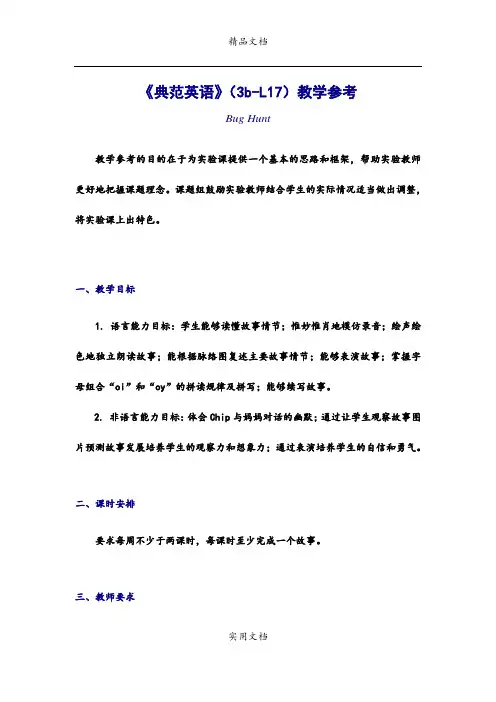
《典范英语》(3b-L17)教学参考Bug Hunt教学参考的目的在于为实验课提供一个基本的思路和框架,帮助实验教师更好地把握课题理念。
课题组鼓励实验教师结合学生的实际情况适当做出调整,将实验课上出特色。
一、教学目标1. 语言能力目标:学生能够读懂故事情节;惟妙惟肖地模仿录音;绘声绘色地独立朗读故事;能根据脉络图复述主要故事情节;能够表演故事;掌握字母组合“oi”和“oy”的拼读规律及拼写;能够续写故事。
2. 非语言能力目标:体会Chip与妈妈对话的幽默;通过让学生观察故事图片预测故事发展培养学生的观察力和想象力;通过表演培养学生的自信和勇气。
二、课时安排要求每周不少于两课时,每课时至少完成一个故事。
三、教师要求1. 教师课前须熟读故事,了解故事内容。
2. 对于较难的单词,教师可板书,并配合动作和表情帮助学生理解。
3. 全英文授课。
四、教学用具多媒体设备、CD机、课件(课题组提供)、道具(two jars, a bug, butter, toast)。
五、课堂教学基本步骤1. 导入(Lead-in):观视频、看图片,激发学生兴趣,引入故事情境(1)教师播放视频Bugs! Bugs! Bugs! 片段,并与学生互动。
First, I would like to show you a video Clip.What’s the video about?What bugs did you see in the video?教师可在PPT上展示部分图片,然后进一步提问,并自然过渡到故事环节:Do you like bugs?Where can you find bugs? (请学生自由回答)Biff and Kipper were looking for bugs in the garden. Did they finda bug? Let’s have a look.2. 看图讲故事(Storytelling):理解故事情节,观察人物表情,体会故事幽默教师利用课件逐幅播放故事图片,并用丰富的表情、生动的英文和适当的肢体语言给学生绘声绘色地讲故事,让学生观察人物的表情,体会故事的幽默。
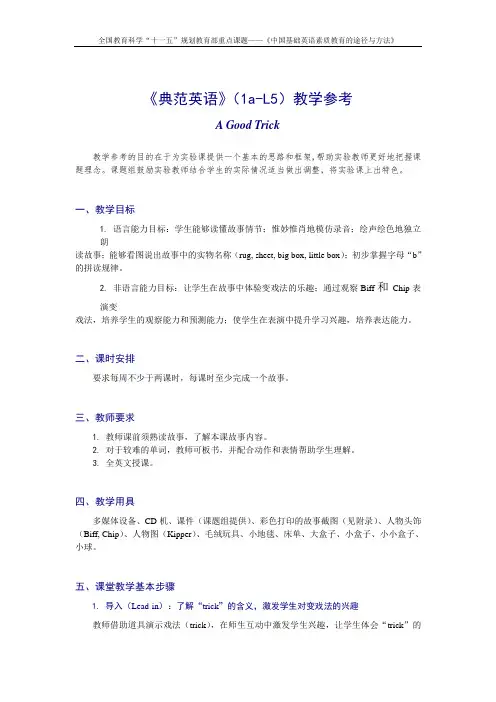
《典范英语》(1a-L5)教学参考A Good Trick教学参考的目的在于为实验课提供一个基本的思路和框架,帮助实验教师更好地把握课题理念。
课题组鼓励实验教师结合学生的实际情况适当做出调整,将实验课上出特色。
一、教学目标1. 语言能力目标:学生能够读懂故事情节;惟妙惟肖地模仿录音;绘声绘色地独立朗读故事;能够看图说出故事中的实物名称(的拼读规律。
2.演变二、课时安排四、教学用具多媒体设备、CD机、课件(课题组提供)、彩色打印的故事截图(见附录)、人物头饰(Biff, Chip)、人物图(Kipper)、毛绒玩具、小地毯、床单、大盒子、小盒子、小小盒子、小球。
五、课堂教学基本步骤1. 导入(Lead-in):了解“trick”的含义,激发学生对变戏法的兴趣教师借助道具演示戏法(trick),在师生互动中激发学生兴趣,让学生体会“trick”的含义。
(1)教师在课前准备好大盒子、小盒子、小小盒子和一个小球,把球装进小小盒子,把小小盒子套入小盒子,最后把小盒子套入大盒子。
(2)把套好的大盒子呈现给学生,提问:What’s this? It’s a box. It’s a big box. 然后请学生猜:What’s in the box? (BQ: Is it a book? Is it a pen?)(3)打开大盒子,取出小盒子,提问:What is it? Oh, it’s a small box. What’s in the small box? (BQ: Is it a teddy bear? Is it a doll?)(4)打开小盒子,取出小小盒子,提问:Look! It’s a smaller box. What’s in the smaller box? (BQ: Is it another box?)(5)打开小小盒子,取出小球,提问:What is it? It’s a ball.之后,教师导入故事:I did a trick just now. Do you like the trick? Is it a good trick? (请学生自由回答)There is a good trick in our book. Shall we read the story? (PPT展示故事标题)2. 看图讲故事(Storytelling教师利用课件逐幅播放故事图片,并用丰富的表情、(Picture 1)It’(指向观众,并另外展(只提问题让学生思考)re going to do a trick. Here’s a rug,” said Biff.(模仿Biff的动作)(教师动作演示)’s under the rug?(Picture 2)It’s a sheet.“Here’s a sheet,” said Chip.(模仿Chip的动作)Biff pulled the sheet off.(教师动作演示)What’s under the sheet? (BQ: Is it a bed?)(让学生观察并猜测)(Picture 3)Look! It’s a big box.(指向图片中的大盒子)Biff and Chip lifted it up.(教师动作演示)What’s under the big box? (指着大盒子下露出的小盒子)(Picture 4)Oh! It’s a little box.(教师展示实物)What’s in the little box? (BQ: Is it Floppy?)(指着小盒子里露出的一抹黄色)(Picture 5)Ah! It’s Kipper. Is it a good trick? (让学生自由作答)What a good trick! Everyone was happy.教师要注意启发学生思考,每次提问之后稍作停顿,不要急于说出答案,先观察学生的反应,如果学生仍回答困难,再进一步给出提示引导学生作答。
《典范英语》(3b-L4)教学参考Nobody Got Wet教学参考的目的在于为实验课提供一个基本的思路和框架,帮助实验教师更好地把握课题理念。
课题组鼓励实验教师结合学生的实际情况适当做出调整,将实验课上出特色。
一、教学目标1. 语言能力目标:学生能够读懂故事情节;惟妙惟肖地模仿录音;绘声绘色地独立朗读故事;能看图复述主要故事情节;能够仿写故事。
2. 非语言能力目标:通过让学生观察一家人野餐过程中的乐趣和遇到的麻烦培养学生的观察力和想象力;通过看图说话培养学生的想象力和语言组织能力;通过复述和讨论培养学生自信表达的勇气。
二、课时安排要求每周不少于两课时,每课时至少完成一个故事。
三、教师要求1. 教师课前须熟读故事,了解故事内容。
2. 对于较难的单词,教师可板书,并配合动作和表情帮助学生理解。
3. 全英文授课。
四、教学用具多媒体设备、CD机、课件(课题组提供)、故事图片、卡片(见表演环节)。
五、课堂教学基本步骤1. 导入(Lead-in):观看视频,设置悬念,引入故事情境(1)教师播放视频The Little Boat(见课件),并与学生互动:We are going to watch a cartoon clip The Little Boat.(2)视频播放完后,教师通过问题引导学生猜测故事结局。
What will happen to Mum and the two children?What will happen to Dad?(3)之后,自然导入故事。
One day, Wilf’s family were on a boat. What did they do? What happened to them? Let’s have a look.2. 看图讲故事(Storytelling):理解故事情节,观察一家人出游的乐趣和遇到的麻烦教师利用课件逐幅播放故事图片,并用丰富的表情、生动的英文和适当的肢体语言给学生绘声绘色地讲故事,让学生注意观察一家人的野餐中看到了什么,遇到了什么样的麻烦。
《典范英语》(3b-L3)教学参考Come In!教学参考的目的在于为实验课提供一个基本的思路和框架,帮助实验教师更好地把握课题理念。
课题组鼓励实验教师结合学生的实际情况适当做出调整,将实验课上出特色。
一、教学目标1. 语言能力目标:学生能够读懂故事情节;惟妙惟肖地模仿录音;绘声绘色地独立朗读故事;能看图复述主要故事情节;能够仿写故事。
2. 非语言能力目标:通过让学生观察图片的细节培养学生的观察力和想象力;培养学生去朋友家玩要懂礼貌;培养学生敢于表达的自信和勇气。
二、课时安排要求每周不少于两课时,每课时至少完成一个故事。
三、教师要求1. 教师课前须熟读故事,了解故事内容。
2. 对于较难的单词,教师可板书,并配合动作和表情帮助学生理解。
3. 全英文授课。
四、教学用具多媒体设备、CD机、课件(课题组提供)、第二课故事图片(第7幅),人物图(Biff, Chip, Kipper, Wilf, Wilma)、图片(见检查理解环节)。
五、课堂教学基本步骤1. 导入(Lead-in):回顾前一课故事,引入故事情境通过展示前一个故事的图片,引导学生回顾故事,引入故事情境。
教师展示第二课第七幅图,并与学生互动:Look at the pictures. Do you still remember what happened to the family?The family moved to the new house.When they moved, what did they say? (展示图片)“Come and play soon.”So one day, some children came to play. Did they have a good time? Let’s have a look.2. 看图讲故事(Storytelling):理解故事情节,观察图片细节教师利用课件逐幅播放故事图片,并用丰富的表情、生动的英文和适当的肢体语言给学生绘声绘色地讲故事,让学生观察共有多少孩子来玩,家里发生了什么事情。
《典范英语》(3b-L20)教学参考Green Sheets教学参考的目的在于为实验课提供一个基本的思路和框架,帮助实验教师更好地把握课题理念。
课题组鼓励实验教师结合学生的实际情况适当做出调整,将实验课上出特色。
一、教学目标1. 语言能力目标:学生能够读懂故事情节;惟妙惟肖地模仿录音;绘声绘色地独立朗读故事;能看图复述主要故事情节;掌握与洗衣服相关的词组(如do the washing, put … in the washing machine, got his washing等);能仿写故事。
2. 非语言能力目标:通过让学生观察洗衣服过程中发生的趣事培养学生的观察力;学会轻松乐观面对一些突发事件;培养学生的自信和勇气。
二、课时安排要求每周不少于两课时,每课时至少完成一个故事。
三、教师要求1. 教师课前须熟读故事,了解故事内容。
2. 对于较难的单词,教师可板书,并配合动作和表情帮助学生理解。
3. 全英文授课。
四、教学用具多媒体设备、CD机、课件(课题组提供)、道具(床单)、句子卡(见环节5)、单词卡(见环节8)。
五、课堂教学基本步骤1. 导入(Lead-in):谈谈洗衣服的话题通过展示图片,联系生活实际,让学生讨论洗衣服的话题,为看图讲故事做好铺垫。
教师展示一张洗衣服的图片,并提问与学生互动:Look at this picture. What’s the girl doing?She is washing clothes.Have you ever washed your clothes?If you were going to wash your clothes, how would you do it?Would you wash by hands?(展示一张手洗衣服的图片)Would you use washing machine?(展示一张洗衣机的图片)Dad was going to do the washing. What did he wash? How did he do it? What happened? Let’s learn the story Green Sheets.2. 看图讲故事(Storytelling):理解故事情节,观察白床单及白色运动服是如何变成绿色的教师利用课件逐幅播放故事图片,并用丰富的表情、生动的英文和适当的肢体语言给学生绘声绘色地讲故事,让学生观察白床单及白色运动服是如何变成绿色的。
《典范英语》(3b-L2)教学参考The New House教学参考的目的在于为实验课提供一个基本的思路和框架,帮助实验教师更好地把握课题理念。
课题组鼓励实验教师结合学生的实际情况适当做出调整,将实验课上出特色。
一、教学目标1. 语言能力目标:学生能够读懂故事情节;惟妙惟肖地模仿录音;绘声绘色地独立朗读故事;能看图复述主要故事情节;能够联系实际围绕搬家展开讨论;能够仿写故事。
2. 非语言能力目标:通过观察孩子们帮忙搬家培养学生的观察力和想象力;了解搬家的辛苦。
二、课时安排要求每周不少于两课时,每课时至少完成一个故事。
三、教师要求1. 教师课前须熟读故事,了解故事内容。
2. 对于较难的单词,教师可板书,并配合动作和表情帮助学生理解。
3. 全英文授课。
四、教学用具多媒体设备、CD机、课件(课题组提供)、第一课故事图片(第一幅和最后一幅)。
五、课堂教学基本步骤1. 导入(Lead-in):回顾上一个故事,引入故事情境通过图片回顾第一课的故事,引出搬家主题,为进入故事情境做好铺垫。
教师展示第一课的第一幅和最后一幅图(见课件),并与学生互动:Look at the pictures. What did the family do in this story?They looked at a new house. Did they buy the house?Yes. They bought it.Would they move to the new house?What happened when they moved to the new house? Let’s learn the story.2. 看图讲故事(Storytelling):理解故事情节,观察一家人搬家的过程教师利用课件逐幅播放故事图片,并用丰富的表情、生动的英文和适当的肢体语言给学生绘声绘色地讲故事,让学生观察孩子们在搬家时帮了什么忙,搬家时发生了什么事。
《典范英语》(3a-L10)教学参考Book Week教学参考的目的在于为实验课提供一个基本的思路和框架,帮助实验教师更好地把握课题理念。
课题组鼓励实验教师结合学生的实际情况适当做出调整,将实验课上出特色。
一、教学目标1. 语言能力目标:学生能够读懂故事情节;惟妙惟肖地模仿录音;绘声绘色地独立朗读故事;能理解并运用book week/author/dressed up/ate/book sale 等单词或词组;能看图完成句子;能够变换视角复述故事情节;能根据提示自制简易故事书。
2. 非语言能力目标:通过让学生观察图片中的时间变化和文字描述培养学生的观察力;使学生感受“读书周”的文化氛围;通过自制图书培养学生的动手动脑能力。
二、课时安排要求每周不少于两课时,每课时至少完成一个故事。
三、教师要求1. 教师课前须熟读故事,了解本课故事相关的文化背景:英国小学普遍重视培养孩子阅读能力,学校以及社区会采取各种举措鼓励孩子阅读。
每所学校都有规模不大、种类齐全、适合学生年龄结构的图书馆(室)。
学校经常组织阅读竞赛,给优胜者一定的奖励,奖品小到贴画,大到名著赠阅等。
学校还会组织孩子们与比较有影响力的作家见面,让孩子们与作家直接对话,分享阅读和写作的感想及经验。
儿童读书周(Children’s Book Week)1919年发轫于美国,后来逐渐扩展到英国等国家。
为了让孩子们享受读书的乐趣,学校、书店、图书馆等机构在读书周里都会组织各种与读书相关的活动和游戏:如自创故事、设计封面、制作绘本、寻宝游戏(Book Hunt)、化装成故事中的人物(fancy dress)、图书售卖(book sale)、图书捐赠(book donation)、聚餐(book picnic)和参观图书馆等。
英国的读书周为每年十月的第一个完整星期(first full week of October every year),如2012年为10月1日至7日,2013年为10月7日至13日。